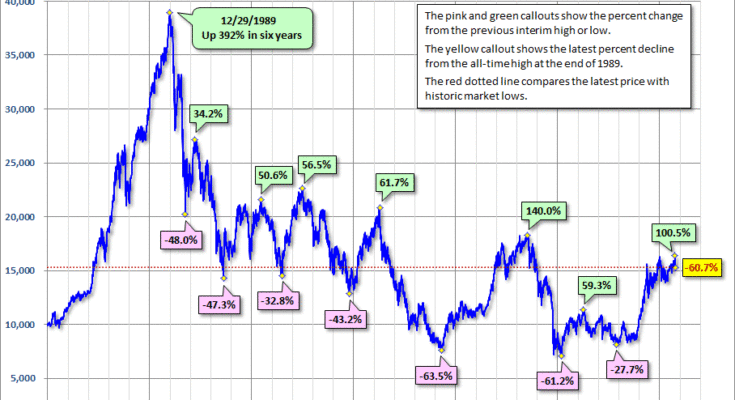It’s been quite a while since my last close look at key Japanese market and bond data. The amazing rally in the Nikkei 225 hit its interim high at the end of December, up 99.6% from its interim low in November of 2011. The steroid effect of massive monetary intervention subsequently evolved into an ongoing drama of high volatility.
What about Japanese government bonds? The closing yield of the 10-year bond on the day the Nikkei hit its 2011 interim low was 1.53%. It was cut in half to 0.75% a year later when the Nikkei hit its November 2012 low shortly before the steroid rally. The yield fell to its 2013 low of 0.44% on April 4, the day that the Bank of Japan disclosed its radical redo of monetary policy. It rebounded to 0.94% on May 29, but it has since dropped 35 basis points at 0.59%. Compare that with the US 10-year note, which closed yesterday over two percent higher at 2.79%.
The Nikkei in Historical Perspective
Here’s a quick review of the Nikkei 225, the 10-year bond and inflation over the past few decades.


The table below documents the advances and declines and the elapsed time for the major cycles in the Nikkei.

The Nominal versus Real Nikkei 225
For most major indexes, we expect to see a significant difference between the nominal and real price over a multi-decade timeframe. But Japan’s chronic bouts of deflation have kept the two metrics rather tight. Note that I’ve used a log vertical axis for the index price to better illustrate the relative price changes over time.


Japanese Bond Yields: How Low Can They Go?
Government bond yields in many safe-haven countries have plunged since the Financial Crisis, although the US 10-year, now hovering around 2.8 percent, is well off its historic closing low of 1.43 percent set in July 2012. The lesson from Japan is that the trend toward lower yields can last a very long time. Here is an overlay of the nominal Nikkei (linear scale) and the 10-year bond along with Japan’s official discount rate. The 10-year yield hit its all-time low in June of 2013, about 10 years ago, at 0.43%. According to Bloomberg, it closed yesterday at 0.59%.

